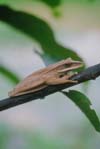Frogs in the Rainforest
 The rain forests of tropical America are not a
uniform realm in which frogs are conspicuous elements. Individual frogs can be rare even
in places that are home to a wealth of species. In part of the Amazon basin where many
species are known to be present, weeks of long night searches may turn up just a few
frogs. When I search for frogs in the Amazonian rain forest of Ecuador, I expect to find a
dozen or two frogs for every hour I spend wandering through the forest. But Ron Heyer and
Ron Crombie, colleagues at the Smithsonian who have searched for frogs in the Brazilian
Amazon, may find only one or two frogs for every hour they spend searching. Sometimes the
scarcity of frogs is temporary, and heavy rains may suddenly reveal their true abundance.
Sometimes they may be patchily abundant, so that when you stumble on the right place you
will find them in large numbers. But in many places they are genuinely rare, and the
reasons for this are poorly understood. (Forsyth & Miyata, 1984). Photo: PhotoDisc Inc.
The rain forests of tropical America are not a
uniform realm in which frogs are conspicuous elements. Individual frogs can be rare even
in places that are home to a wealth of species. In part of the Amazon basin where many
species are known to be present, weeks of long night searches may turn up just a few
frogs. When I search for frogs in the Amazonian rain forest of Ecuador, I expect to find a
dozen or two frogs for every hour I spend wandering through the forest. But Ron Heyer and
Ron Crombie, colleagues at the Smithsonian who have searched for frogs in the Brazilian
Amazon, may find only one or two frogs for every hour they spend searching. Sometimes the
scarcity of frogs is temporary, and heavy rains may suddenly reveal their true abundance.
Sometimes they may be patchily abundant, so that when you stumble on the right place you
will find them in large numbers. But in many places they are genuinely rare, and the
reasons for this are poorly understood. (Forsyth & Miyata, 1984). Photo: PhotoDisc Inc.
Worldwide Decline in Frog Populations
 The scientists speculated that where obvious
habitat destruction by bulldozer and chain saw wasn't a cause, other, less visible
problems were killing the animals: acid rain, drought, pesticides, human exploitation
(killing and collecting for food and the pet trade), and new predators, such as fish
introduced for sport fishing. A few suggested that ozone layer depletion or global
climatic change might be having effects, especially on high-mountain species or on species
living on the margins of their natural ranges. (Phillips, 1994). Photo:
PhotoDisc Inc.
The scientists speculated that where obvious
habitat destruction by bulldozer and chain saw wasn't a cause, other, less visible
problems were killing the animals: acid rain, drought, pesticides, human exploitation
(killing and collecting for food and the pet trade), and new predators, such as fish
introduced for sport fishing. A few suggested that ozone layer depletion or global
climatic change might be having effects, especially on high-mountain species or on species
living on the margins of their natural ranges. (Phillips, 1994). Photo:
PhotoDisc Inc.






